Big Data: Definition, Challenges, and Impact on Business Organizations
VerifiedAdded on 2023/06/09
|8
|2205
|309
AI Summary
This report explains the concept and characteristics of big data, challenges faced by companies due to big data and its analytics, and how big data technologies influence businesses. It also discusses the methodologies to examine big data and how it helps businesses in reducing costs, increasing revenue, making pricing decisions, gaining competitive advantage, and making better decisions.
Contribute Materials
Your contribution can guide someone’s learning journey. Share your
documents today.
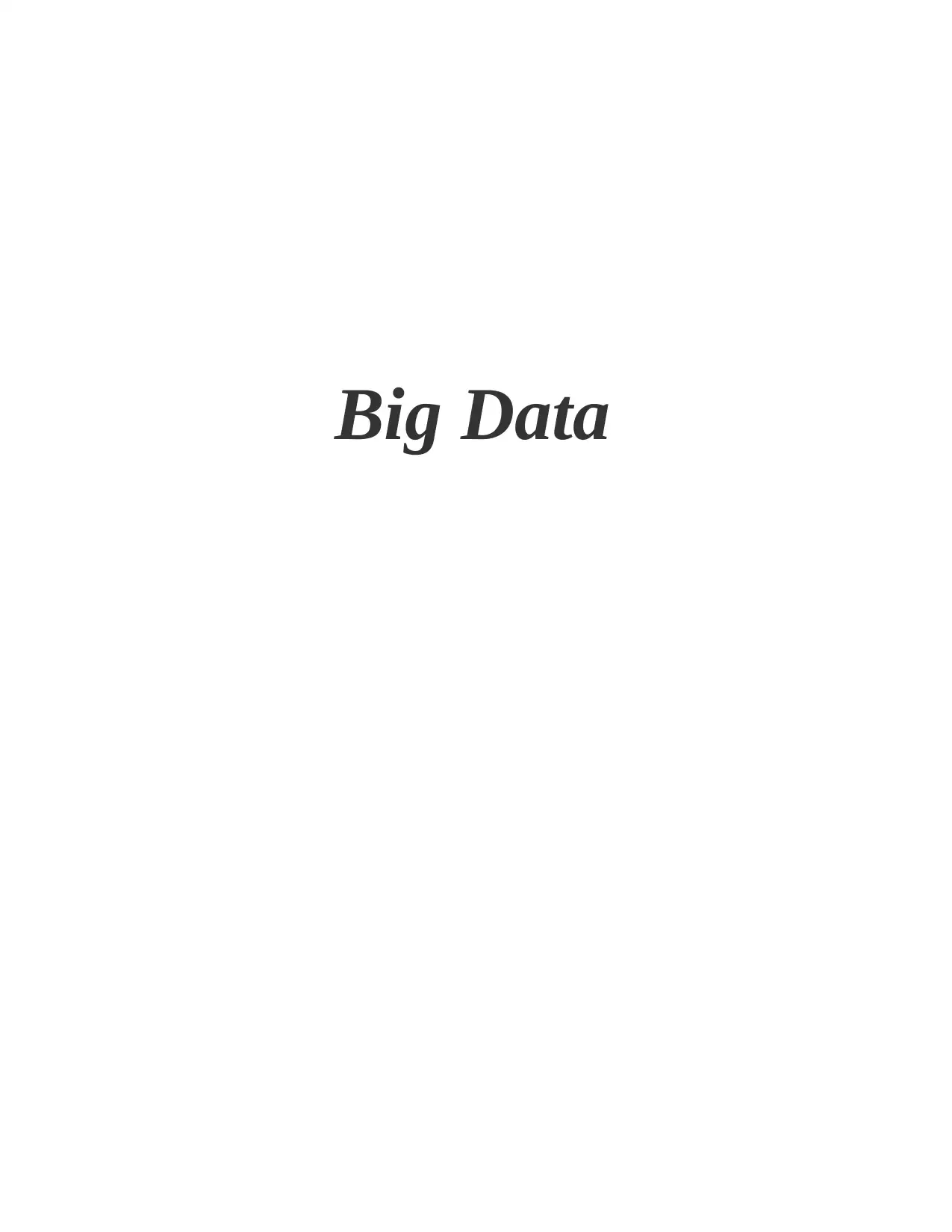
Big Data
Secure Best Marks with AI Grader
Need help grading? Try our AI Grader for instant feedback on your assignments.
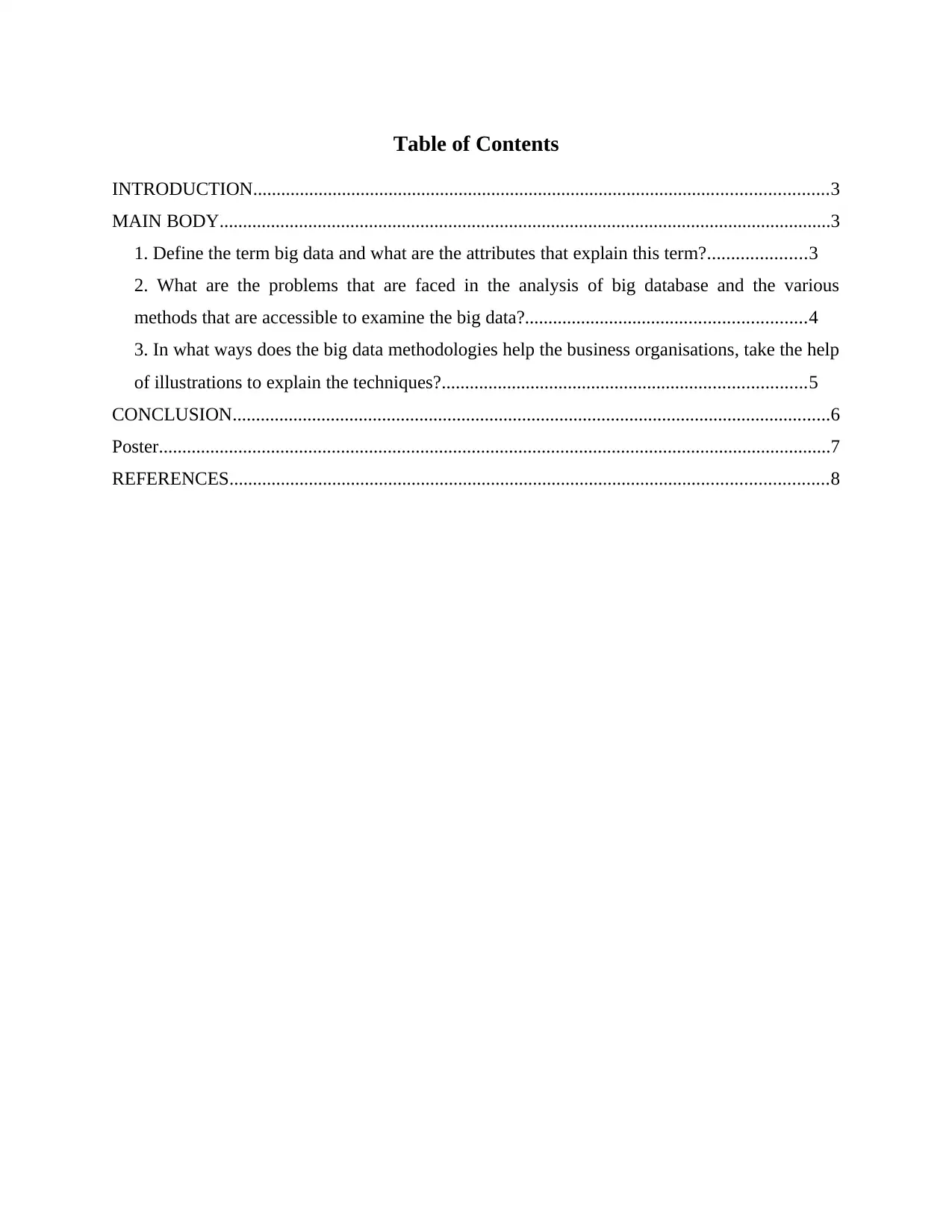
Table of Contents
INTRODUCTION...........................................................................................................................3
MAIN BODY...................................................................................................................................3
1. Define the term big data and what are the attributes that explain this term?.....................3
2. What are the problems that are faced in the analysis of big database and the various
methods that are accessible to examine the big data?............................................................4
3. In what ways does the big data methodologies help the business organisations, take the help
of illustrations to explain the techniques?..............................................................................5
CONCLUSION................................................................................................................................6
Poster................................................................................................................................................7
REFERENCES................................................................................................................................8
INTRODUCTION...........................................................................................................................3
MAIN BODY...................................................................................................................................3
1. Define the term big data and what are the attributes that explain this term?.....................3
2. What are the problems that are faced in the analysis of big database and the various
methods that are accessible to examine the big data?............................................................4
3. In what ways does the big data methodologies help the business organisations, take the help
of illustrations to explain the techniques?..............................................................................5
CONCLUSION................................................................................................................................6
Poster................................................................................................................................................7
REFERENCES................................................................................................................................8
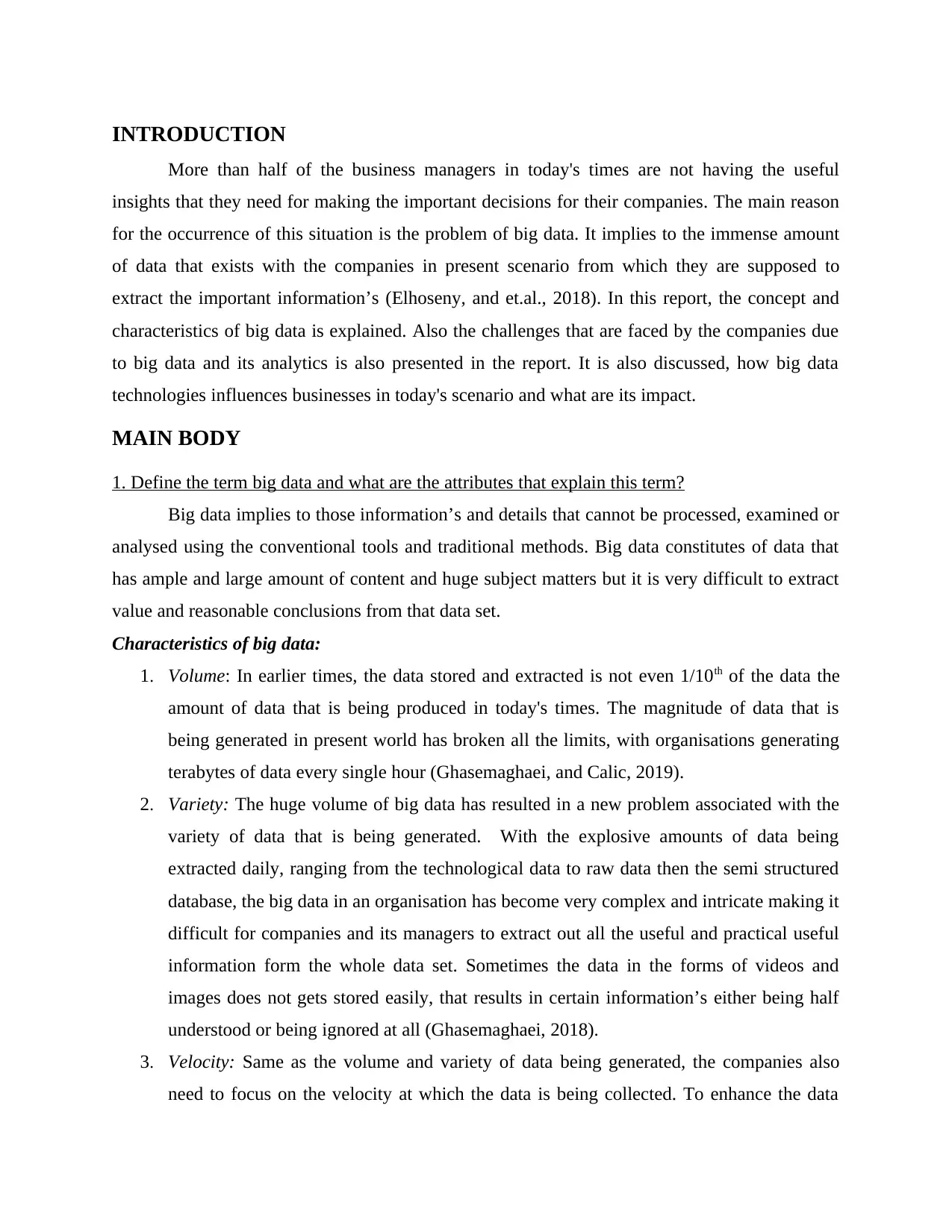
INTRODUCTION
More than half of the business managers in today's times are not having the useful
insights that they need for making the important decisions for their companies. The main reason
for the occurrence of this situation is the problem of big data. It implies to the immense amount
of data that exists with the companies in present scenario from which they are supposed to
extract the important information’s (Elhoseny, and et.al., 2018). In this report, the concept and
characteristics of big data is explained. Also the challenges that are faced by the companies due
to big data and its analytics is also presented in the report. It is also discussed, how big data
technologies influences businesses in today's scenario and what are its impact.
MAIN BODY
1. Define the term big data and what are the attributes that explain this term?
Big data implies to those information’s and details that cannot be processed, examined or
analysed using the conventional tools and traditional methods. Big data constitutes of data that
has ample and large amount of content and huge subject matters but it is very difficult to extract
value and reasonable conclusions from that data set.
Characteristics of big data:
1. Volume: In earlier times, the data stored and extracted is not even 1/10th of the data the
amount of data that is being produced in today's times. The magnitude of data that is
being generated in present world has broken all the limits, with organisations generating
terabytes of data every single hour (Ghasemaghaei, and Calic, 2019).
2. Variety: The huge volume of big data has resulted in a new problem associated with the
variety of data that is being generated. With the explosive amounts of data being
extracted daily, ranging from the technological data to raw data then the semi structured
database, the big data in an organisation has become very complex and intricate making it
difficult for companies and its managers to extract out all the useful and practical useful
information form the whole data set. Sometimes the data in the forms of videos and
images does not gets stored easily, that results in certain information’s either being half
understood or being ignored at all (Ghasemaghaei, 2018).
3. Velocity: Same as the volume and variety of data being generated, the companies also
need to focus on the velocity at which the data is being collected. To enhance the data
More than half of the business managers in today's times are not having the useful
insights that they need for making the important decisions for their companies. The main reason
for the occurrence of this situation is the problem of big data. It implies to the immense amount
of data that exists with the companies in present scenario from which they are supposed to
extract the important information’s (Elhoseny, and et.al., 2018). In this report, the concept and
characteristics of big data is explained. Also the challenges that are faced by the companies due
to big data and its analytics is also presented in the report. It is also discussed, how big data
technologies influences businesses in today's scenario and what are its impact.
MAIN BODY
1. Define the term big data and what are the attributes that explain this term?
Big data implies to those information’s and details that cannot be processed, examined or
analysed using the conventional tools and traditional methods. Big data constitutes of data that
has ample and large amount of content and huge subject matters but it is very difficult to extract
value and reasonable conclusions from that data set.
Characteristics of big data:
1. Volume: In earlier times, the data stored and extracted is not even 1/10th of the data the
amount of data that is being produced in today's times. The magnitude of data that is
being generated in present world has broken all the limits, with organisations generating
terabytes of data every single hour (Ghasemaghaei, and Calic, 2019).
2. Variety: The huge volume of big data has resulted in a new problem associated with the
variety of data that is being generated. With the explosive amounts of data being
extracted daily, ranging from the technological data to raw data then the semi structured
database, the big data in an organisation has become very complex and intricate making it
difficult for companies and its managers to extract out all the useful and practical useful
information form the whole data set. Sometimes the data in the forms of videos and
images does not gets stored easily, that results in certain information’s either being half
understood or being ignored at all (Ghasemaghaei, 2018).
3. Velocity: Same as the volume and variety of data being generated, the companies also
need to focus on the velocity at which the data is being collected. To enhance the data
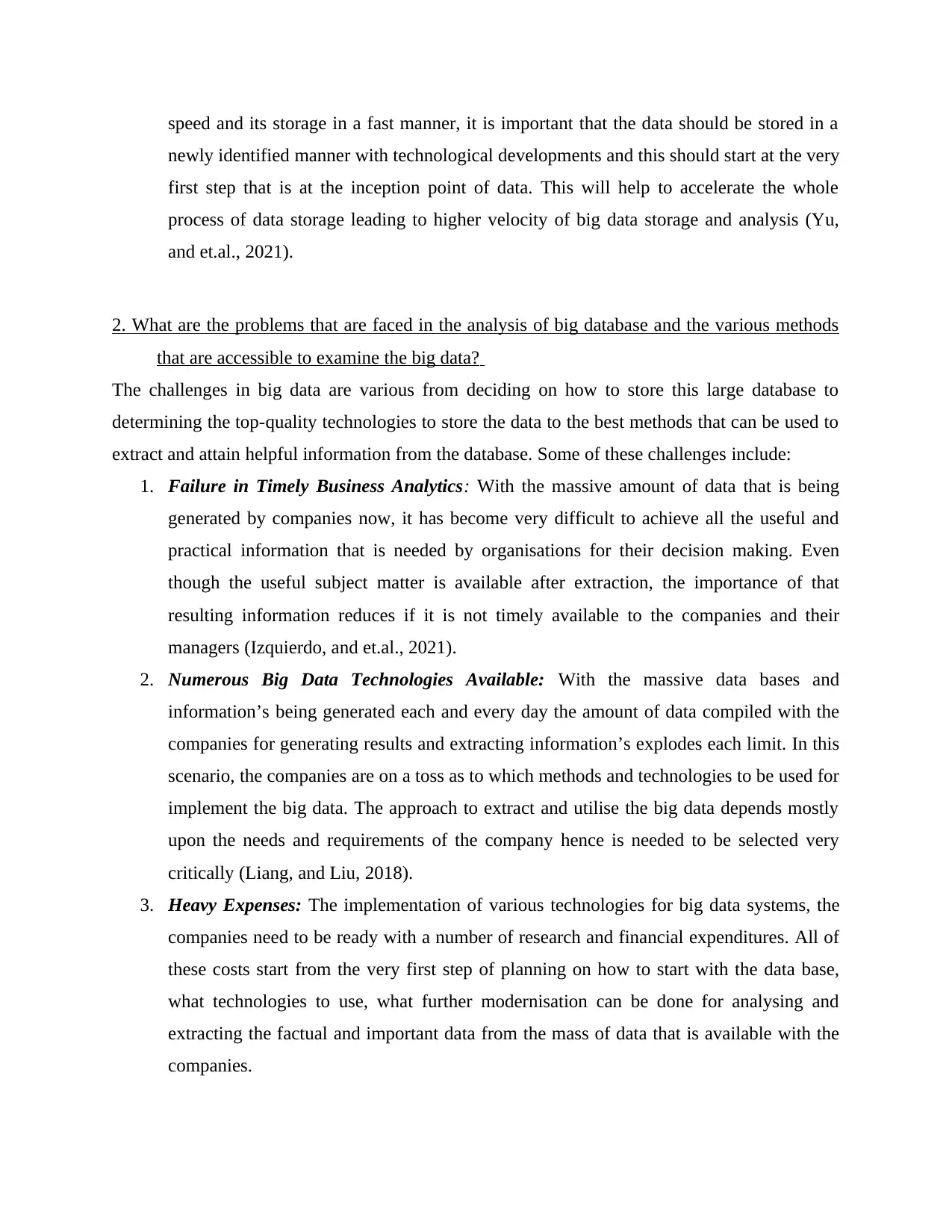
speed and its storage in a fast manner, it is important that the data should be stored in a
newly identified manner with technological developments and this should start at the very
first step that is at the inception point of data. This will help to accelerate the whole
process of data storage leading to higher velocity of big data storage and analysis (Yu,
and et.al., 2021).
2. What are the problems that are faced in the analysis of big database and the various methods
that are accessible to examine the big data?
The challenges in big data are various from deciding on how to store this large database to
determining the top-quality technologies to store the data to the best methods that can be used to
extract and attain helpful information from the database. Some of these challenges include:
1. Failure in Timely Business Analytics: With the massive amount of data that is being
generated by companies now, it has become very difficult to achieve all the useful and
practical information that is needed by organisations for their decision making. Even
though the useful subject matter is available after extraction, the importance of that
resulting information reduces if it is not timely available to the companies and their
managers (Izquierdo, and et.al., 2021).
2. Numerous Big Data Technologies Available: With the massive data bases and
information’s being generated each and every day the amount of data compiled with the
companies for generating results and extracting information’s explodes each limit. In this
scenario, the companies are on a toss as to which methods and technologies to be used for
implement the big data. The approach to extract and utilise the big data depends mostly
upon the needs and requirements of the company hence is needed to be selected very
critically (Liang, and Liu, 2018).
3. Heavy Expenses: The implementation of various technologies for big data systems, the
companies need to be ready with a number of research and financial expenditures. All of
these costs start from the very first step of planning on how to start with the data base,
what technologies to use, what further modernisation can be done for analysing and
extracting the factual and important data from the mass of data that is available with the
companies.
newly identified manner with technological developments and this should start at the very
first step that is at the inception point of data. This will help to accelerate the whole
process of data storage leading to higher velocity of big data storage and analysis (Yu,
and et.al., 2021).
2. What are the problems that are faced in the analysis of big database and the various methods
that are accessible to examine the big data?
The challenges in big data are various from deciding on how to store this large database to
determining the top-quality technologies to store the data to the best methods that can be used to
extract and attain helpful information from the database. Some of these challenges include:
1. Failure in Timely Business Analytics: With the massive amount of data that is being
generated by companies now, it has become very difficult to achieve all the useful and
practical information that is needed by organisations for their decision making. Even
though the useful subject matter is available after extraction, the importance of that
resulting information reduces if it is not timely available to the companies and their
managers (Izquierdo, and et.al., 2021).
2. Numerous Big Data Technologies Available: With the massive data bases and
information’s being generated each and every day the amount of data compiled with the
companies for generating results and extracting information’s explodes each limit. In this
scenario, the companies are on a toss as to which methods and technologies to be used for
implement the big data. The approach to extract and utilise the big data depends mostly
upon the needs and requirements of the company hence is needed to be selected very
critically (Liang, and Liu, 2018).
3. Heavy Expenses: The implementation of various technologies for big data systems, the
companies need to be ready with a number of research and financial expenditures. All of
these costs start from the very first step of planning on how to start with the data base,
what technologies to use, what further modernisation can be done for analysing and
extracting the factual and important data from the mass of data that is available with the
companies.
Secure Best Marks with AI Grader
Need help grading? Try our AI Grader for instant feedback on your assignments.
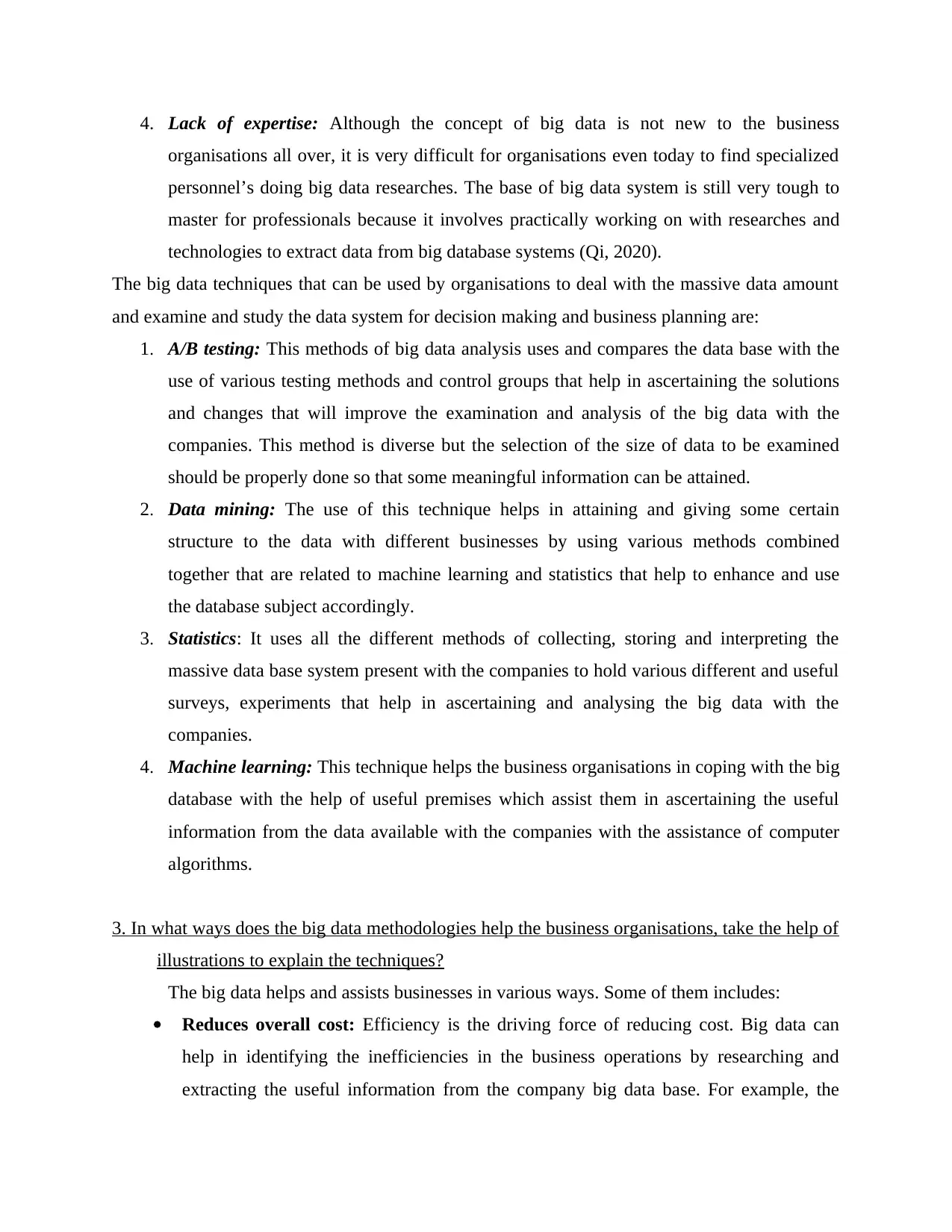
4. Lack of expertise: Although the concept of big data is not new to the business
organisations all over, it is very difficult for organisations even today to find specialized
personnel’s doing big data researches. The base of big data system is still very tough to
master for professionals because it involves practically working on with researches and
technologies to extract data from big database systems (Qi, 2020).
The big data techniques that can be used by organisations to deal with the massive data amount
and examine and study the data system for decision making and business planning are:
1. A/B testing: This methods of big data analysis uses and compares the data base with the
use of various testing methods and control groups that help in ascertaining the solutions
and changes that will improve the examination and analysis of the big data with the
companies. This method is diverse but the selection of the size of data to be examined
should be properly done so that some meaningful information can be attained.
2. Data mining: The use of this technique helps in attaining and giving some certain
structure to the data with different businesses by using various methods combined
together that are related to machine learning and statistics that help to enhance and use
the database subject accordingly.
3. Statistics: It uses all the different methods of collecting, storing and interpreting the
massive data base system present with the companies to hold various different and useful
surveys, experiments that help in ascertaining and analysing the big data with the
companies.
4. Machine learning: This technique helps the business organisations in coping with the big
database with the help of useful premises which assist them in ascertaining the useful
information from the data available with the companies with the assistance of computer
algorithms.
3. In what ways does the big data methodologies help the business organisations, take the help of
illustrations to explain the techniques?
The big data helps and assists businesses in various ways. Some of them includes:
Reduces overall cost: Efficiency is the driving force of reducing cost. Big data can
help in identifying the inefficiencies in the business operations by researching and
extracting the useful information from the company big data base. For example, the
organisations all over, it is very difficult for organisations even today to find specialized
personnel’s doing big data researches. The base of big data system is still very tough to
master for professionals because it involves practically working on with researches and
technologies to extract data from big database systems (Qi, 2020).
The big data techniques that can be used by organisations to deal with the massive data amount
and examine and study the data system for decision making and business planning are:
1. A/B testing: This methods of big data analysis uses and compares the data base with the
use of various testing methods and control groups that help in ascertaining the solutions
and changes that will improve the examination and analysis of the big data with the
companies. This method is diverse but the selection of the size of data to be examined
should be properly done so that some meaningful information can be attained.
2. Data mining: The use of this technique helps in attaining and giving some certain
structure to the data with different businesses by using various methods combined
together that are related to machine learning and statistics that help to enhance and use
the database subject accordingly.
3. Statistics: It uses all the different methods of collecting, storing and interpreting the
massive data base system present with the companies to hold various different and useful
surveys, experiments that help in ascertaining and analysing the big data with the
companies.
4. Machine learning: This technique helps the business organisations in coping with the big
database with the help of useful premises which assist them in ascertaining the useful
information from the data available with the companies with the assistance of computer
algorithms.
3. In what ways does the big data methodologies help the business organisations, take the help of
illustrations to explain the techniques?
The big data helps and assists businesses in various ways. Some of them includes:
Reduces overall cost: Efficiency is the driving force of reducing cost. Big data can
help in identifying the inefficiencies in the business operations by researching and
extracting the useful information from the company big data base. For example, the
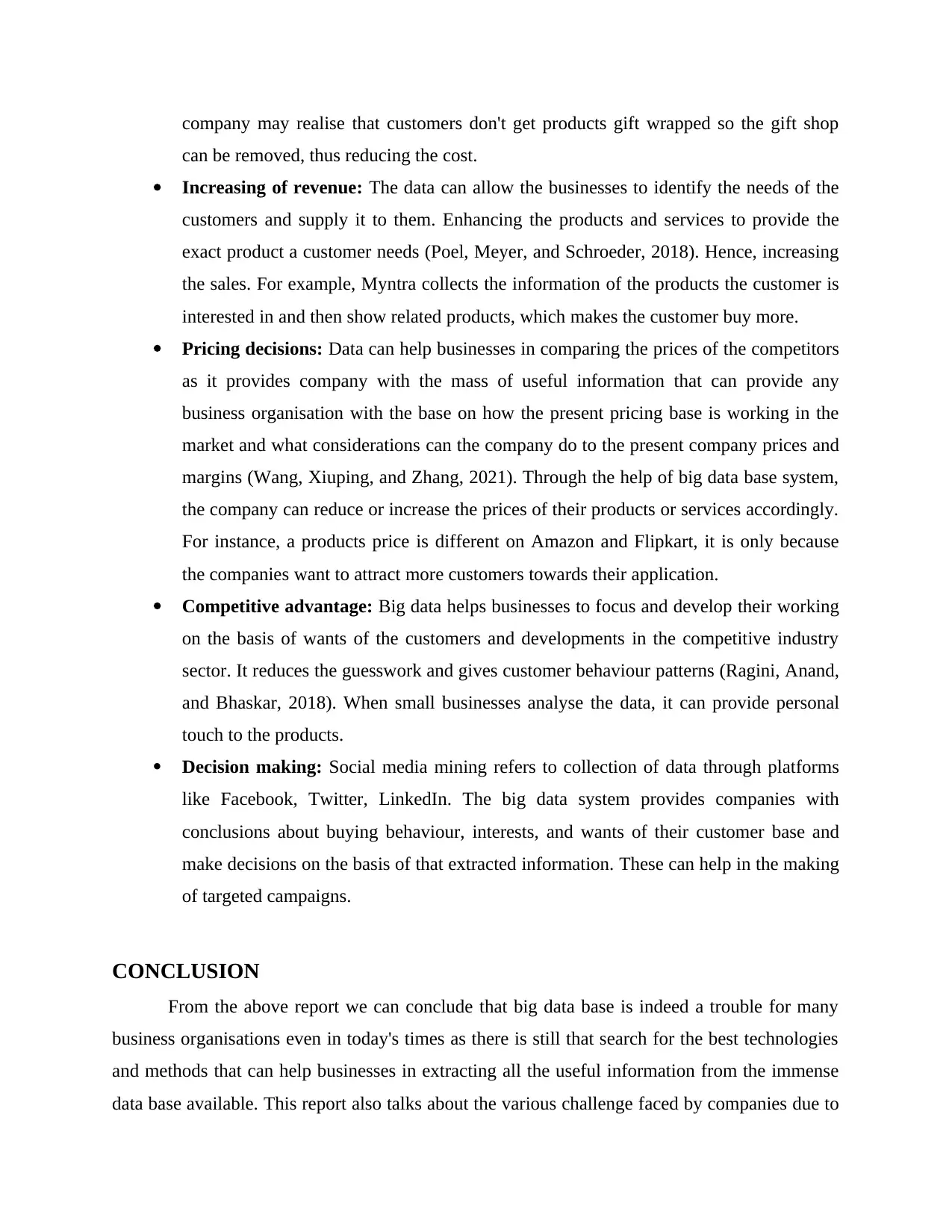
company may realise that customers don't get products gift wrapped so the gift shop
can be removed, thus reducing the cost.
Increasing of revenue: The data can allow the businesses to identify the needs of the
customers and supply it to them. Enhancing the products and services to provide the
exact product a customer needs (Poel, Meyer, and Schroeder, 2018). Hence, increasing
the sales. For example, Myntra collects the information of the products the customer is
interested in and then show related products, which makes the customer buy more.
Pricing decisions: Data can help businesses in comparing the prices of the competitors
as it provides company with the mass of useful information that can provide any
business organisation with the base on how the present pricing base is working in the
market and what considerations can the company do to the present company prices and
margins (Wang, Xiuping, and Zhang, 2021). Through the help of big data base system,
the company can reduce or increase the prices of their products or services accordingly.
For instance, a products price is different on Amazon and Flipkart, it is only because
the companies want to attract more customers towards their application.
Competitive advantage: Big data helps businesses to focus and develop their working
on the basis of wants of the customers and developments in the competitive industry
sector. It reduces the guesswork and gives customer behaviour patterns (Ragini, Anand,
and Bhaskar, 2018). When small businesses analyse the data, it can provide personal
touch to the products.
Decision making: Social media mining refers to collection of data through platforms
like Facebook, Twitter, LinkedIn. The big data system provides companies with
conclusions about buying behaviour, interests, and wants of their customer base and
make decisions on the basis of that extracted information. These can help in the making
of targeted campaigns.
CONCLUSION
From the above report we can conclude that big data base is indeed a trouble for many
business organisations even in today's times as there is still that search for the best technologies
and methods that can help businesses in extracting all the useful information from the immense
data base available. This report also talks about the various challenge faced by companies due to
can be removed, thus reducing the cost.
Increasing of revenue: The data can allow the businesses to identify the needs of the
customers and supply it to them. Enhancing the products and services to provide the
exact product a customer needs (Poel, Meyer, and Schroeder, 2018). Hence, increasing
the sales. For example, Myntra collects the information of the products the customer is
interested in and then show related products, which makes the customer buy more.
Pricing decisions: Data can help businesses in comparing the prices of the competitors
as it provides company with the mass of useful information that can provide any
business organisation with the base on how the present pricing base is working in the
market and what considerations can the company do to the present company prices and
margins (Wang, Xiuping, and Zhang, 2021). Through the help of big data base system,
the company can reduce or increase the prices of their products or services accordingly.
For instance, a products price is different on Amazon and Flipkart, it is only because
the companies want to attract more customers towards their application.
Competitive advantage: Big data helps businesses to focus and develop their working
on the basis of wants of the customers and developments in the competitive industry
sector. It reduces the guesswork and gives customer behaviour patterns (Ragini, Anand,
and Bhaskar, 2018). When small businesses analyse the data, it can provide personal
touch to the products.
Decision making: Social media mining refers to collection of data through platforms
like Facebook, Twitter, LinkedIn. The big data system provides companies with
conclusions about buying behaviour, interests, and wants of their customer base and
make decisions on the basis of that extracted information. These can help in the making
of targeted campaigns.
CONCLUSION
From the above report we can conclude that big data base is indeed a trouble for many
business organisations even in today's times as there is still that search for the best technologies
and methods that can help businesses in extracting all the useful information from the immense
data base available. This report also talks about the various challenge faced by companies due to
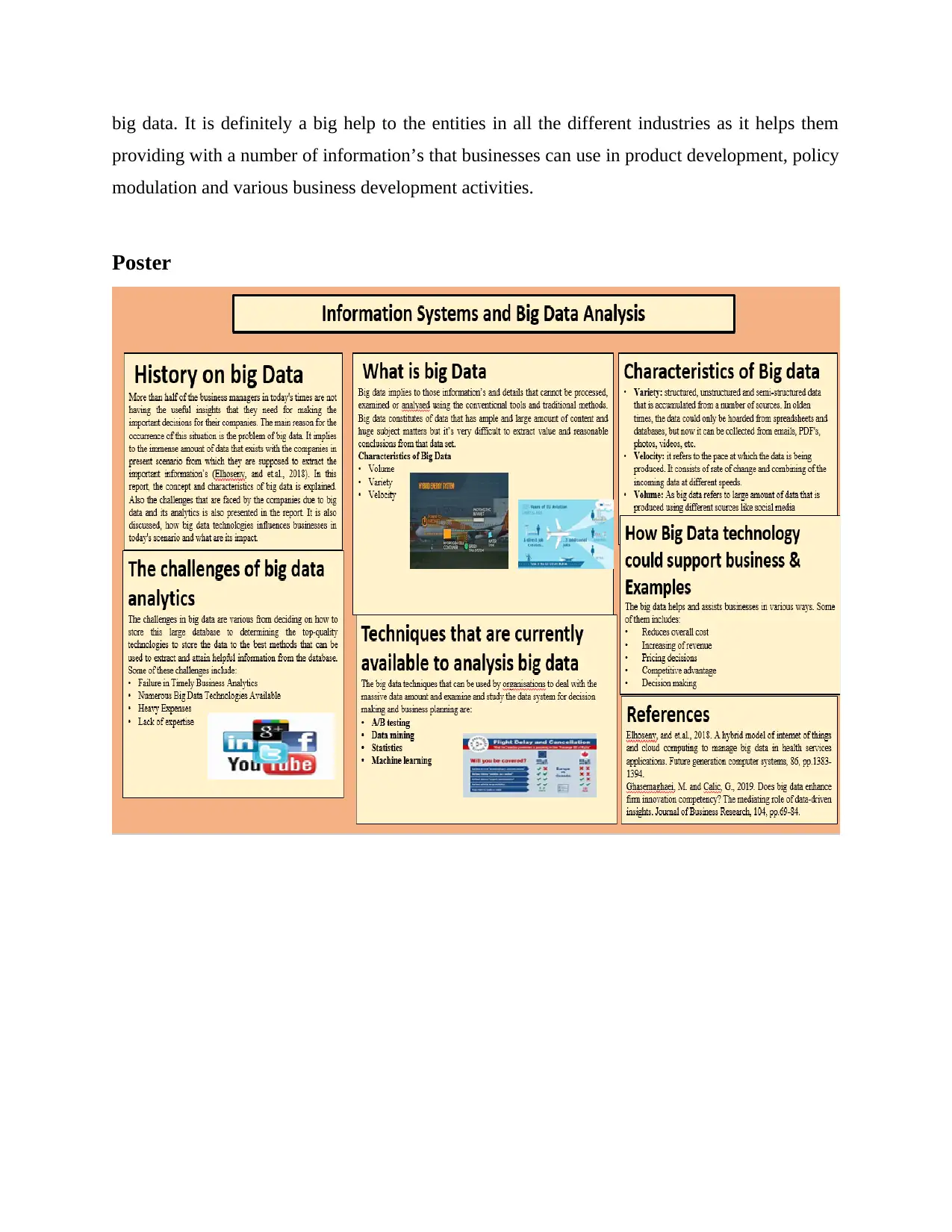
big data. It is definitely a big help to the entities in all the different industries as it helps them
providing with a number of information’s that businesses can use in product development, policy
modulation and various business development activities.
Poster
providing with a number of information’s that businesses can use in product development, policy
modulation and various business development activities.
Poster
Paraphrase This Document
Need a fresh take? Get an instant paraphrase of this document with our AI Paraphraser
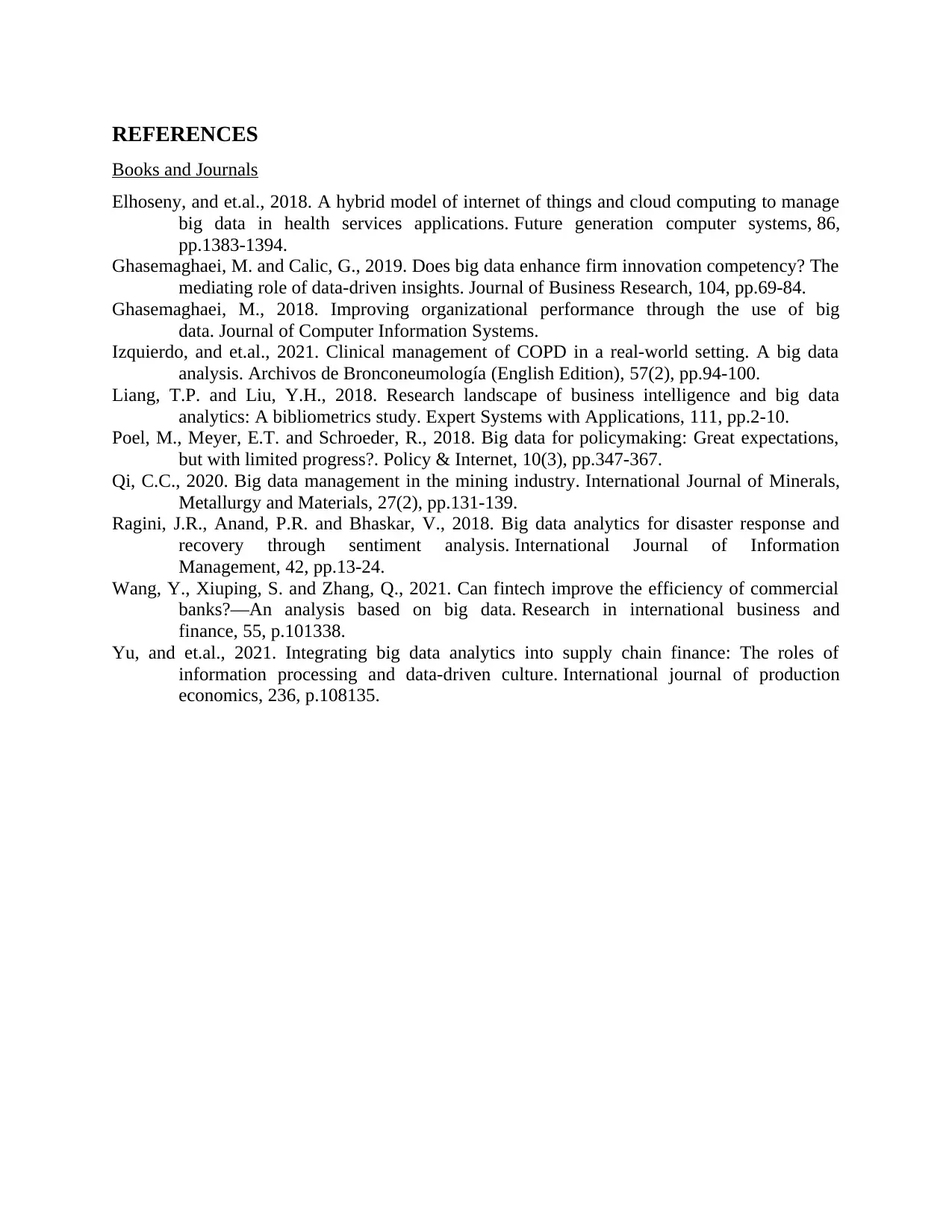
REFERENCES
Books and Journals
Elhoseny, and et.al., 2018. A hybrid model of internet of things and cloud computing to manage
big data in health services applications. Future generation computer systems, 86,
pp.1383-1394.
Ghasemaghaei, M. and Calic, G., 2019. Does big data enhance firm innovation competency? The
mediating role of data-driven insights. Journal of Business Research, 104, pp.69-84.
Ghasemaghaei, M., 2018. Improving organizational performance through the use of big
data. Journal of Computer Information Systems.
Izquierdo, and et.al., 2021. Clinical management of COPD in a real-world setting. A big data
analysis. Archivos de Bronconeumología (English Edition), 57(2), pp.94-100.
Liang, T.P. and Liu, Y.H., 2018. Research landscape of business intelligence and big data
analytics: A bibliometrics study. Expert Systems with Applications, 111, pp.2-10.
Poel, M., Meyer, E.T. and Schroeder, R., 2018. Big data for policymaking: Great expectations,
but with limited progress?. Policy & Internet, 10(3), pp.347-367.
Qi, C.C., 2020. Big data management in the mining industry. International Journal of Minerals,
Metallurgy and Materials, 27(2), pp.131-139.
Ragini, J.R., Anand, P.R. and Bhaskar, V., 2018. Big data analytics for disaster response and
recovery through sentiment analysis. International Journal of Information
Management, 42, pp.13-24.
Wang, Y., Xiuping, S. and Zhang, Q., 2021. Can fintech improve the efficiency of commercial
banks?—An analysis based on big data. Research in international business and
finance, 55, p.101338.
Yu, and et.al., 2021. Integrating big data analytics into supply chain finance: The roles of
information processing and data-driven culture. International journal of production
economics, 236, p.108135.
Books and Journals
Elhoseny, and et.al., 2018. A hybrid model of internet of things and cloud computing to manage
big data in health services applications. Future generation computer systems, 86,
pp.1383-1394.
Ghasemaghaei, M. and Calic, G., 2019. Does big data enhance firm innovation competency? The
mediating role of data-driven insights. Journal of Business Research, 104, pp.69-84.
Ghasemaghaei, M., 2018. Improving organizational performance through the use of big
data. Journal of Computer Information Systems.
Izquierdo, and et.al., 2021. Clinical management of COPD in a real-world setting. A big data
analysis. Archivos de Bronconeumología (English Edition), 57(2), pp.94-100.
Liang, T.P. and Liu, Y.H., 2018. Research landscape of business intelligence and big data
analytics: A bibliometrics study. Expert Systems with Applications, 111, pp.2-10.
Poel, M., Meyer, E.T. and Schroeder, R., 2018. Big data for policymaking: Great expectations,
but with limited progress?. Policy & Internet, 10(3), pp.347-367.
Qi, C.C., 2020. Big data management in the mining industry. International Journal of Minerals,
Metallurgy and Materials, 27(2), pp.131-139.
Ragini, J.R., Anand, P.R. and Bhaskar, V., 2018. Big data analytics for disaster response and
recovery through sentiment analysis. International Journal of Information
Management, 42, pp.13-24.
Wang, Y., Xiuping, S. and Zhang, Q., 2021. Can fintech improve the efficiency of commercial
banks?—An analysis based on big data. Research in international business and
finance, 55, p.101338.
Yu, and et.al., 2021. Integrating big data analytics into supply chain finance: The roles of
information processing and data-driven culture. International journal of production
economics, 236, p.108135.
1 out of 8
Related Documents
Your All-in-One AI-Powered Toolkit for Academic Success.
+13062052269
info@desklib.com
Available 24*7 on WhatsApp / Email
![[object Object]](/_next/static/media/star-bottom.7253800d.svg)
Unlock your academic potential
© 2024 | Zucol Services PVT LTD | All rights reserved.



